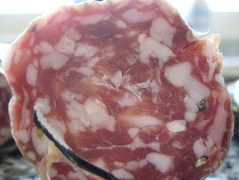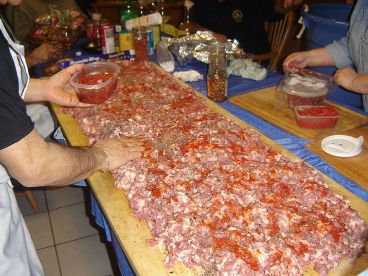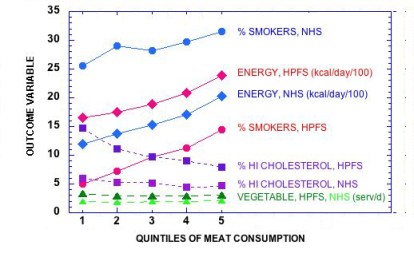I thought that, for a change of pace, I would take a Mediterranean perspective. The Mediterranean Diet is widely considered as an ideal diet since it is not explicitly low-fat (most of the time) while still allowing people to avoid saying low-carbohydrate which is not fashionable in many circles. At the end of this post, however, I have included a couple of recipes from Judy Barnes Baker’s new cookbook, Nourished; a Cookbook for Health, Weight Loss, and Metabolic Balance. For general health, Mediterranean diets have the advantage that nobody is really sure what they are and hence there are no long term trials of the type that makes low-fat diets look so bad, as in the Women’s Health Initiative.
Tournedos Rossini
Start with Giochino Rossini. It is generally known that his life as a composer included significant time for food. He retired in his forties and devoted the rest of his life to cooking and eating. (William Tell was his last opera). Rossini said that he had only cried twice as an adult. The first time was when he heard Paganini play the violin and the second, when a truffled turkey fell in the water at a boating party.

Because his later life was more or less in seclusion, there is some confusion about his gastronomic experiences. It is not even clear whether Tournedos Rossini was made for him or by him. In fact it is not even clear where the name Tournedos comes from. Derived from tourner en dos, turning to the back, it may refer to the method of cooking or possibly that somebody had to turn their back during the preparation so as not to let anyone see the secret of the final sauce. The recipe, although simple in outline, has expensive ingredients and the final sauce will determine the quality of the chef. It simply involves frying a steak and then putting a slab of pate de foie gras with truffles on top. The sauce is based on a beef reduction. More at Global Gourmet.

- Sauté the 4 center-cut filets mignons, chain muscle removed, 6 ounces in the 2 tablespoons (30 milliliters) clarified butter or vegetable oil on both sides until rare.
- Remove excess fat with with paper towel and place on heated plates.
- Place warm pate de foie gras slices on each tournedo.
- Cover with Périgueux Sauce:
Bring 1-1/2 cups (375 milliliters) of demi-glace to slow simmer. Add 5 tablespoons (75 milliliters) of truffle essence and 2 ounces (50 grams) of either chopped or sliced truffles. Off heat and cover with tight-fitting lid, allow truffles to infuse into the sauce for at least 15 minutes. (The sauce using truffles sliced into shapes rather than pieces is called Périgourdine).
5. Finish with a little truffle butter.
Lardo di Colonnata
Not really a make-at-home item, this traditional creation from Tuscany captures the care in processing that makes Italian food famous. The original curing method supposedly goes back to the year 1000, and has been handed down from generation to generation. The lard, of course, comes from pigs that have not undergone the genetic transformation that American pigs have. In any case, you will need marble tubs which you should keep in the basement assuming that there are no caves in your neighborhood. You rub the tubs with garlic and then layer the pork lard and cover with brine, add sea salt and spices and herbs. You continue with additional layers until the tub is full and then cover with a wooden lid. Curing time is about 6 to 10 months.

Greek Barbecue
As described on one of the Greek food sites “anyone visiting Greece would wonder exactly what is meant by the Mediterranean diet for while those of us outside the Med have been eating more whole grains, extra virgin olive oil and fresh vegetables…. as the Greeks become more affluent they eat more meat.” I haven’t been in Greece for many years but I remember quite a bit of meat then. Of course, in Greece, as elsewhere, affluence is a sometime thing but the trend is for festive holiday foods to be increasingly available all year round. The most popular food for Easter is whole lamb roasted on a spit The recipe is simple, if not convenient for the small family “You will need 1 whole lamb, skinned and gutted…” Seasoning can be simple salt and pepper or basted with ladolemono, mixture of lemon juice, olive oil and oregano.

As the site points out, Lamb on the spit “is especially popular [at Easter] because it follows 40 days of fasting for lent and people are definitely ready for some meat, though not everyone fasts the entire forty days.” This reminds me of little known angle on the Seven Countries study.
Ancel Keys auf Naxos
The idea of a Mediterranean diet derives, in some way, from Ancel Keys’s Seven Countries study. He discovered that the two countries with the highest consumption of fat, had the lowest incidence of cardiovascular disease (Crete) and the highest (Finland), and he attributed this to the type of fat, olive oil for Crete and animal fat for Finland. It was later pointed out that there were large differences in CVD between different areas of Finland that had the same diet. This information was ignored by Keys who was also a pioneer in this approach to conflicting data. Another of the rarely cited responses to the Seven Countries study was a letter written by Katerina Sarri and Anthony Kafatos of the University of Crete and published in the journal Public Health Nutrition: 8(6), 666 (2005):
“In the December 2004 issue of your journal…Geoffrey Cannon referred to … the fact that Keys and his colleagues seemed to have ignored the possibility that Greek Orthodox Christian fasting practices could have influenced the dietary habits of male Cretans in the 1960s. For this reason, we had a personal communication with Professor Christos Aravanis, who was responsible for carrying out and following up the Seven Countries Study in Greece. Professor Aravanis confirmed that, in the 1960s, 60% of the study participants were fasting during the 40 days of Lent, and strictly followed all fasting periods of the church according to the Greek Orthodox Church dietary doctrines. These mainly prescribe the periodic abstention from meat, fish, dairy products, eggs and cheese, as well as abstention from olive oil consumption on certain Wednesdays and Fridays….”
“this was not noted in the study, and no attempt was made to differentiate between fasters and non-fasters. In our view this was a remarkable and troublesome omission.”
Kokoretsi.
Leopold Bloom ate with relish the inner organs of beasts and fowls. He liked thick giblet soup, nutty gizzards, a stuffed roast heart, liver slices fried with crustcrumbs, fried hencod’s roes. Most of all he liked grilled mutton kidneys which gave to his palate a fine tang of faintly scented urine.
— James Joyce, Ulysses.
Along with Greek Barbecue, it is traditional at Easter to serve kokoretsi which is made from the internal organs of the lamb. Liver, spleen, heart, glands are threaded onto skewers along with the fatty membrane from the lamb intestines. When the skewer is full, the lamb intestines are wrapped around the whole creation. It is then barbecued over low heat for about 3-5 hours.

One of the regrettable aspects of the decline in food quality in the United States is the general disappearance of organ meats although the Paleo movement may help with this. Organ meats were once very popular; the quotation above is probably the second most widely quoted passage from James Joyce’s Ulysses. Because of various ethnic influences, they were probably more popular in New York than in America (which begins somewhere in New Jersey). I found Jimmy Moore’s confrontation with beef tongue quite remarkable in that (in its corned form (like corned beef)), tongue was once a staple of my diet. When I was in grade school, there were many weeks where I would bring tongue sandwiches on Silvercup bread for lunch every day. Silvercup, made in Queens was the New York version of Wonder Bread. The Silvercup sign is still a fixture of the New York landscape — it is now the site of Silvercup Studios, the major film and television production company that kept the name (and the sign) when the Bakery folded and the studio bought the building in 1983. (You name the TV show, it was probably produced at Silvercup).

Of course, everybody draws the line somewhere. Although I used to eat with my friends at Puglia, the Little Italy restaurant that specialized in whole sheep’s head, I passed on this delicacy mostly because of the eyeballs. Also, although you gotta’ love the euphemism Rocky Mountain Oysters, bull testicles don’t do it for me, at least if I know for sure in advance. (I don’t really mind, in retrospect, if the folk-myths about the tacos that I ate outside the bullring in Mexico City were really true).
Etymology of Food Words
Whether it is the steak or the cook whose back is turned in Tournedos, it is generally difficult to find the etymology of food words, although some are obvious. The conversion of Welsh Rabbit to Welsh Rarebit is surely an attempt to be more politically correct and avoid Welsh profiling. One disagreement that I remember from way back when I was in college is now settled. There used to be many ideas about the origin of the word pumpernickel. One of my favorites at the time was that Napoleon had said that it was “pain pour Nicole” (his horse). Great but not true, it is now agreed that it comes from the German, pampern, to fart and Nickel meaning goblin, along the lines of Saint Nick for Santa Claus. So pumpernickel means Devil’s Fart presumably due to the effect of the unprocessed grain that gives it its earthy quality. Which reminds me of the ADA’s take on fiber that I quoted in an earlier post: “it is important that you increase your fiber intake gradually, to prevent stomach irritation, and that you increase your intake of water and other liquids, to prevent constipation.” foods with fiber “have a wealth of nutrition, containing many important vitamins and minerals.” In fact, fiber “may contain nutrients that haven’t even been discovered yet!” (their exclamation point).
In Brooklyn, the Mediterranean diet means Italian sausage, largely from Southern Italy. I had always assumed that Soppresata (pronounced, as in Naples, without the final vowel) was so-called because it was super-saturated with fat, but I have been unable to confirm this; since first writing this post, Italian friends have suggested that it comes from Sop-pressata, that is “pressed on,” but this is also unconfirmed. There are many varieties but supposedly the best is from Calabria. For something like this, with so many varieties which each cook is sure is the best, there is no exact recipe, but you can get started with this from About.com Italian Food.
6.6 pounds (3 k) of pork meat — a combination of loin and other lean cuts
1 pound (500 g) lard (a block of fat)
1 pound (500 g) pork side, the cut used to make bacon
Salt, pepper
Cloves, garlic and herbs (rosemary, lemon peel, parsley etc
1/2 cup grappa (I think you could also use brandy if you want)
The basic ideas is to remove all the gristle, and chop it with the lard and the pork side. About.com recommends a meat grinder but I suspect that the knife blade of a food processor is better. Then, wash the casing well in vinegar, dry it thoroughly, and rub with a mixture of well ground salt and pepper. “Shake away the excess, fill the casing, pressing down so as to expel all air, close the casing, and tie the salami with string. Hang for 2-3 days in a warm place, and then for a couple of months in a cool, dry, drafty spot and the sopressata is ready.”


At exactly what moment these simple, natural ingredients turn into processed red meat is unknown.
Simple Mediterranean
I’ve included two recipes from Judy Barnes Baker’s new book, Nourished; a Cookbook for Health, Weight Loss, and Metabolic Balance. Currently in press, publication will be announced on her website. For very simple Mediterranean, she suggested the following from the The Silver Spoon. Translated from Il cucchiaio d’argento, published in 1950 by Editoriale Domas, the back cover describes it as “the bible of authentic Italian cooking and Italy’s best-selling cookbook for the last fifty years.”
Eggs En Cocotte with Bacon Fat
Serves 4
4 small slices bacon fat
4 tablespoons heavy cream
4 eggs
2 tablespoons Parmesan cheese, freshly grated
Preheat the oven to 350º, if you wish to bake the eggs. Parboil the bacon fat in boiling water for about 1 minute, then drain. Put 1 tablespoon cream and a slice of bacon fat in each of four ramekins, break an egg into each and sprinkle with the Parmesan. Place the ramekins in a roasting pan, add boiling water to come about halfway up the sides and bake for 6-8 minutes or until the egg whites are lightly set. Alternatively, place the roasting pan over low heat for 6-8 minutes. The combination of bacon fat and cream—a strong savory taste and a milder flavor—gives the eggs a very delicate flavor.
Recipes from: Nourished; a Cookbook for Health, Weight Loss, and Metabolic Balance (Judy Barnes Baker is the author although I and others are mistakenly listed by Amazon as co-authors).

Καλή όρεξη
















